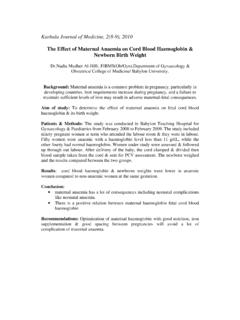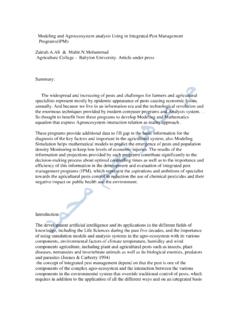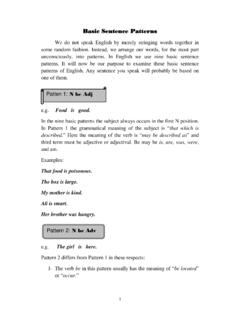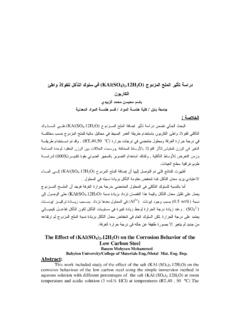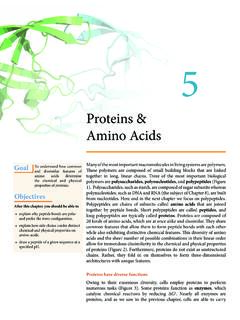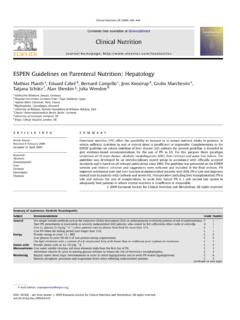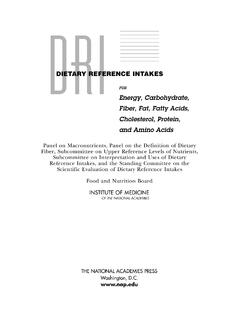Transcription of EXPERIMENT 2- QUALITATIVE ANALYSIS OF AMINO ACIDS …
1 EXPERIMENT 2- QUALITATIVE ANALYSIS OF AMINO ACIDS AND PROTEINS AMINO ACIDS are molecules containing an amine group, a carboxylic acid group and a side chain that varies betwen different AMINO ACIDS . AMINO ACIDS of the general formula RCH(NH2)COOH are amphoteric, behaving as amines in some reactions and as carboxylic ACIDS in others. At a certain pH known as the isoelectric point an AMINO acid has no overall charge, since the number of protonated ammonium groups (positive charges) and deprotonated carboxylate groups (negative charges) are equal.
2 Since the AMINO ACIDS at their isoelectric points have both negative and positive charges, they are known as zwitterions. AMINO ACIDS are critical to life. They have particularly important functions like being the building blocks of proteins and being the intermediates in metabolism. AMINO ACIDS are generally classified by the properties of their side chain into four groups. The side chain can make an AMINO acid a weak acid or a weak base, and a hydrophile if the side chain is polar or a hydrophobe if it is nonpolar. Proteins (also known as polypeptides) are organic compounds made of AMINO ACIDS arranged in a linear chain.
3 The AMINO ACIDS in a polymer are joined together by the peptide bonds between the carboxyl and the AMINO groups of adjacent AMINO acid residues. Like other biological macromolecules such as polysaccharides and nucleic ACIDS , proteins are essential parts of organisms and participate in virtually every process within cells. Proteins are important in: - catalyzing biochemical reactions (enzymes) - structural and mechanical functions (actin and myosin) - cell signaling - immune responses - cell adhesion - cell cycle TESTS ON AMINO ACIDS : 1) Solubility Tests: The solubility of AMINO ACIDS and proteins is largely dependent on the solution pH.
4 The structural changes in an AMINO acid or protein that take place at different pH values alter the relative solubility of the molecule. In acidic solutions, both AMINO and carboxylic groups are protonated. In basic solutions, both groups are deprotonated. AMINO ACIDS are essentially soluble in water. Their solubilities in water, dilute alkali and dilute acid vary from one compound to the other depending on the structure of their side chains. Apply this test to glycine, tyrosine, glutamic acid and cysteine. Procedure: - Note the solubility of AMINO ACIDS in water and alcohol by placing a small amount in a test tube, adding a few mL of solvent and warming if necessary.
5 - Determine the AMINO acid solution is acidic or basic by using a litmus paper while testing the solubility in water. - Repeat the solubility test using dilute HCl and dilute NaOH. 2) Ninhydrin Test: Ninhydrin (triketohydrindene hydrate) is a chemical used to detect ammoniaor primary and secondary amines. AMINO ACIDS also react with ninhydrin at pH=4. The reduction product obtained from ninhydrin then reacts with NH3 and excess ninhydrin to yield a blue colored substance. This reaction provides an extremely sensitive test for AMINO ACIDS .
6 Apply this test to any of the AMINO ACIDS you choose. WARNING: Avoid spilling ninhydrin solutions on your skin, as the resulting stains are difficult to remove. (Ninhydrin is the most commonly used method to detect fingerprints, as the terminal amines or lysine residues in peptides and proteins sloughed off in fingerprints react with ninhydrin). Procedure: - To 1 mL AMINO acid solution add 5 drops of ninhydrine solution in acetone. - Boil over a water bath for 2 min. - Allow to cool and observe the blue color formed. Questions: Write the reaction(s) involved in Ninhydrin Test.
7 3) Stability to Alkali: AMINO ACIDS , unlike amides and volatile amines, do not evolve NH3 or alkaline vapor when boiled with alkali. This method can be used to differentiate AMINO ACIDS from amines and amides. Apply this test to the provided amine or amide and also to glycine. Procedure: - Pipette 1 mL 1% glycine and the amide or amine solution into separate test tubes. - Add 1 mL dilute NaOH to each test tube and boil. - Test the vapor from each boiling tube with wet litmus paper. Questions: What type of reaction is responsible for the evolution of alkaline vapor?
8 Write the reaction and explain briefly. 4) Specific Reactions for Individual AMINO ACIDS : WARNING: Please DO NOT use vast amounts of solution for these tests, since most of the AMINO ACIDS are very expensive!! a) Xanthoproteic Test: Some AMINO ACIDS contain aromatic groups that are derivatives of benzene. These aromatic groups can undergo reactions that are characteristics of benzene and benzene derivatives. One such reaction is the nitration of a benzene ring with nitric acid . The AMINO ACIDS that have activated benzene ring can readily undergo nitration.
9 This nitration reaction, in the presence of activated benzene ring, forms yellow product. Apply this test to tyrosine, tryptophan, phenylalanine and glutamic acid . Procedure: - To 2 mL AMINO acid solution in a boiling test tube, add equal volume of concentrated HNO3. - Heat over a flame for 2 min and observe the color. - Now COOL THOROUGHLY under the tap and CAUTIOSLY run in sufficient 40% NaOH to make the solution strongly alkaline. - Observe the color of the nitro derivativative of aromatic nucleus. Questions: Write the reaction(s) involved in Xanthoproteic Test.
10 Define activated benzene ring , briefly. Do all the AMINO ACIDS with aromatic side chains give positive result? Why? b) Millon s Test: Millon s test is specific to phenol containing structures (tyrosine is the only common phenolic AMINO acid ). Millon s reagent is concentrated HNO3, in which mercury is dissolved. As a result of the reaction a red precipitate or a red solution is considered as positive test. A yellow precipitate of HgO is NOT a positive reaction but usually indicates that the solution is too alkaline. Apply this test to tyrosine, phenylalanine, glycine and -naphtol.

